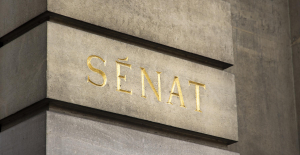Iraq on Sunday unveiled a nearly 2,800-year-old cuneiform tablet, just returned by Italy, during a ceremony held at a presidential palace in Baghdad. The tablet bears the insignia of Shalmaneser III, an Assyrian king who ruled the region of Nimrod in northern Mesopotamia from 858 to 823 BCE.
“I would like to thank Italian officials for their efforts and their cooperation which made it possible to bring this piece back,” Iraqi President Abdel Latif Rachid said on Sunday, before sending the tablet to the National Museum in Baghdad. This restitution comes at a time when Iraq is intensifying its efforts to recover from foreign countries the antiquities looted from the many archaeological sites that punctuate its territory.
The circumstances of the arrival in Italy of the tablet of King Shalmaneser remain obscure. The object was recently seized by the Carabinieri, after which the Italian authorities returned the piece to Abdel Latif Rachid during a visit by the Iraqi president to Bologna on June 14. Iraqi Culture Minister Ahmed Fakak al-Badrani acknowledged that the circumstances in which the tablet was discovered remained unclear. "Perhaps during archaeological excavations or during the work of the Mosul dam," he said. The director of the Iraqi Council of Antiquities and Heritage, Laith Majid Hussein, mentioned that the tablet “came to Italy in the 1980s”.
Small in size, the archaeological piece is no less important, said Fakak al-Badrani. “Its cuneiform text has been fully preserved,” rejoiced the minister. The tablet “bears the titles of King Shalmaneser III and those of his father Ashurnasirpal II and his grandfather. Just as it recalls the construction of a ziggurat”, imposing building with degrees in the region of Nimrod, also indicated Laith Majid Hussein to AFP. During his long reign, Shalmaneser III continued the aggressive policy of territorial expansion of Assyria initiated by his predecessors, towards the Anatolian plateau and the Zagros Mountains, in present-day Iran.
Cradle of the civilizations of Sumer, Akkad, Babylon and Assyria, to which humanity owes writing and the first cities, Iraq has suffered for decades from the looting of its antiquities. The phenomenon increased in the chaos of the American invasion of 2003, then during the rise of the Islamic State (IS) group in 2014. “We will continue to work to recover from abroad all the archaeological pieces in Iraqi history, promised the Iraqi President. We want to make the Iraqi National Museum one of the best museums in the world and we will work on it”.
In May, New York prosecutor Alvin Bragg returned two ancient sculptures to Iraq: a Mesopotamian limestone elephant and a Sumerian alabaster bull from the archaeological city of Uruk. The figurines, stolen during the Gulf War, arrived clandestinely in New York in the late 1990s, according to a press release from the prosecution. The bull was part of the private collection of Shelby White, an 85-year-old billionaire, trustee and Met donor.

 Gaza: under the spotlight, the Israeli-Palestinian conflict shakes up the Eurovision contest
Gaza: under the spotlight, the Israeli-Palestinian conflict shakes up the Eurovision contest Black soldier killed by a police officer in the United States: the sheriff publishes the video of the arrest
Black soldier killed by a police officer in the United States: the sheriff publishes the video of the arrest In Malmö, the Eurovision party transformed into entrenched camps
In Malmö, the Eurovision party transformed into entrenched camps In Russia, Vladimir Putin stigmatizes “Western elites”
In Russia, Vladimir Putin stigmatizes “Western elites” Fatal case of cholera in Mayotte: the epidemic is “contained”, assures the government
Fatal case of cholera in Mayotte: the epidemic is “contained”, assures the government The presence of blood in the urine, a warning sign of bladder cancer
The presence of blood in the urine, a warning sign of bladder cancer A baby whose mother smoked during pregnancy will age more quickly
A baby whose mother smoked during pregnancy will age more quickly The euro zone economy grows in April at its best pace in almost a year but inflationary pressure increases
The euro zone economy grows in April at its best pace in almost a year but inflationary pressure increases IBM, Amazon, Hager... These record investments expected at the Choose France summit
IBM, Amazon, Hager... These record investments expected at the Choose France summit Boeing's black streak: a second Air France flight diverted in three days for “a smell of heat”
Boeing's black streak: a second Air France flight diverted in three days for “a smell of heat” Tesla: demonstrators try to break into a factory in Germany
Tesla: demonstrators try to break into a factory in Germany Argentina: a second general strike in five months against Javier Milei
Argentina: a second general strike in five months against Javier Milei “I want to apologize”: Kendji Girac speaks for the first time since his injury
“I want to apologize”: Kendji Girac speaks for the first time since his injury Gollum at the heart of the next Lord of the Rings film and controversies
Gollum at the heart of the next Lord of the Rings film and controversies In Paris, the redevelopment of the squares between Bastille and the Saint-Martin canal displeases some residents
In Paris, the redevelopment of the squares between Bastille and the Saint-Martin canal displeases some residents Cate Blanchett in majesty at the San Sebastian Festival
Cate Blanchett in majesty at the San Sebastian Festival Omoda 7, another Chinese car that could be manufactured in Spain
Omoda 7, another Chinese car that could be manufactured in Spain BYD chooses CA Auto Bank as financial partner in Spain
BYD chooses CA Auto Bank as financial partner in Spain Tesla and Baidu sign key agreement to boost development of autonomous driving
Tesla and Baidu sign key agreement to boost development of autonomous driving Skoda Kodiaq 2024: a 'beast' plug-in hybrid SUV
Skoda Kodiaq 2024: a 'beast' plug-in hybrid SUV The home mortgage firm rises 3.8% in February and the average interest moderates to 3.33%
The home mortgage firm rises 3.8% in February and the average interest moderates to 3.33% This is how housing prices have changed in Spain in the last decade
This is how housing prices have changed in Spain in the last decade The home mortgage firm drops 10% in January and interest soars to 3.46%
The home mortgage firm drops 10% in January and interest soars to 3.46% The jewel of the Rocío de Nagüeles urbanization: a dream villa in Marbella
The jewel of the Rocío de Nagüeles urbanization: a dream villa in Marbella Diving into the secrets of the National Assembly
Diving into the secrets of the National Assembly Institutions: senators want to restore the accumulation of mandates and put an end to the automatic presence of ex-presidents on the Constitutional Council
Institutions: senators want to restore the accumulation of mandates and put an end to the automatic presence of ex-presidents on the Constitutional Council Europeans: David Lisnard expresses his “essential and vital” support for François-Xavier Bellamy
Europeans: David Lisnard expresses his “essential and vital” support for François-Xavier Bellamy Facing Jordan Bardella, the popularity match turns to Gabriel Attal’s advantage
Facing Jordan Bardella, the popularity match turns to Gabriel Attal’s advantage These French cities that will boycott the World Cup in Qatar
These French cities that will boycott the World Cup in Qatar Tour of Italy: Pogacar wins the individual time trial and takes off overall
Tour of Italy: Pogacar wins the individual time trial and takes off overall Top 14: Clermont with a Lanen-Jedrasiak team on the second line and young people on the bench against Perpignan
Top 14: Clermont with a Lanen-Jedrasiak team on the second line and young people on the bench against Perpignan Top 14: first for Tuisova, associated with Fickou in the center with Racing 92 against Bayonne
Top 14: first for Tuisova, associated with Fickou in the center with Racing 92 against Bayonne Top 14: Toulon without Jaminet but with young Domon to face Lyon
Top 14: Toulon without Jaminet but with young Domon to face Lyon


















